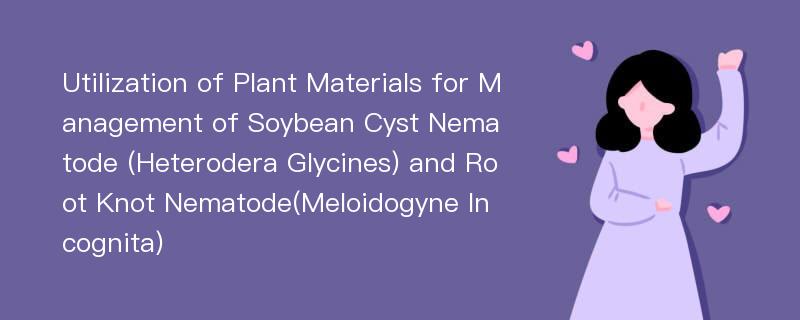
论文摘要
大豆孢囊线虫Heterodera glycines Ichinohe1952)是大豆(Glycine max)和其他作物上的专性寄生线虫,是大豆上的最重要的有害生物之一,在全球造成的产量损失估计为20亿美元。根结线虫属(.Meloidogyne spp.)是作物上最具经济危害性的三个植物寄生线虫属之一。它们在自然界分布广泛,是超过3000种不同寄主植物根部的专性寄生线虫。爪哇根结线虫、花生根结线虫、南方根结线虫、北方根结线虫是世界范围内的主要害虫,这四种造成损失约占由根结线虫引起农业损失的90%。针对植物线虫病害目前最常用的防治方法之一是使用化学合成杀线剂。杀线剂尽管非常高效,但是由于对环境破坏效应而在全球范围被重新评估。本研究旨在寻找环保型的,针对大豆孢囊线虫和南方根结线虫的替代杀线剂。主要研究成果如下:1.对山西省太谷县的大豆孢囊线虫群体进行分子鉴定,获得的PCR产物经纯化、克隆和序列测定。基于大豆上的孢囊线虫的rDNA-ITS序列及近似种等系统进化分析,显示大豆孢囊线虫与异皮属的其他种之间有一些遗传变异。2.四种植物材料的水提物在浓度为120μg/ml时,能不同程度的抑制大豆孢囊线虫的孵化,处理96小时后,印楝,菜籽饼,金合欢海草等植物源材料对卵孵化抑制百分率分别为75.21%,62.90%,41.80%和26.23%。A indica的水提物在120μg/ml的条件下,间隔85小时后,对二龄幼虫的致死率为100%,B. chinensis, A. nilotica and E.maxima的水提物对二龄幼虫的致死率分别为68.34%,43.34%和23.34%。四种植物材料的水提物在120μg/ml的浓度时抑制南方根结线虫卵孵化。间隔96小时后,A. indica, B. chinensis, A. nilotica和E. maxima的平均卵孵化抑制率分别是70.3,58.4,43.2和16.2%。在12μg/ml的低浓度下,尽管观察到的平均抑制率降低,但是也遵循类似趋势,SDW对照处理未抑制卵孵化。此外,所有植物水提物显著不同,比起对照造成根结线虫2龄幼虫更高的死亡率。A. indica的水提物在浓度为120μg/ml下,间隔84小时,对2龄幼虫的平均致死率为100%,B.chinensis, A. nilotica和E. maxima对2龄幼虫的致死率分别为81.3,54.5和39.4%。3.温室实验结果表明:应用A. indica, B. chinensis, A. nilotica and E. maxima的水提物,对大豆孢囊线虫发育的抑制效果分别为83.12%,66.23%,50.65%和40.26%。四种植物材料的浓度为120μg/ml时,大豆的生长参数如,枝重,根长,干枝重,根重均有不同程度增加。不过,A. indica产生了最高的平均枝高-68.7cm, E. maxima, B. chinensis and A. nilotica产生的平均枝高分别为61.2cm,59.7cm and43.2cm,对照平均枝高最矮(32.3cm)。其他的生长参数,例如平均根长、干枝重、干根重也遵循一个类似趋势。4.田间试验表明:应用最高比例的四种植物材料(200g,450g,1000g和2000g)显著降低田间大豆孢囊线虫群体密度;杀线剂、印度楝、菜籽饼、金合欢和海草等植物材料处理后大豆孢囊线虫群体密度分别减少57.9%,48.3%,41.4%,34.5%和28.3%;在单株豆荚相应的分别增加46.6%,58.7%,33.7%,28%和37.9%。6.基于富集培养,生物学,农业和临床试验测试ammonia oxidizing archaea (AOA氨氧化古菌)产生的气体的毒性。研究表明:AOA产生的N2O,甲烷以及其它有毒气体对线虫和小鼠的毒性。在临床实验中,用古细菌气体对小鼠处理5和7小时,对收集的血液进行生化分析,发现与未经古细菌气体处理的对照小鼠手机的血液相比,对照组13个参数中的12个显著改变。本研究结果表明,这些植物材料是合成化学农药的潜在替代物,能应用于可持续农业系统,保护环境和生物多样性。因此,需要进行更精确的研究,开发植物杀线剂的有效配方以便优化用量,经济有效的防治线虫病害。此外氨氧化古菌有潜在的应用价值。
论文目录
Acknowledgements摘要AbstractList of abbreviations use in this thesisChapter 1 Introduction1.1 Introduction1.2 Soybean(Glycines max (L.) Merrill) and its utilization1.3 Aims and objectives of the study1.4 Research justification1.4.1 Alleviation of nematode threats to global food security1.4.2 Mitigation of agricultural greenhouse gasses (AGHG) emissions1.4.3 Commitment made by China to reduce carbon emission1.4.4 Environmental protection1.4.5 Natural resource developmentChapter 2 Literature review2.1 Nematode as pests of crops2.2 Crop yield losses due to soybean cyst nematode(Heterodera glycines Ichinohe 1952)2.3 Crop yield losses due to root knot nematode(Meloidogyne spp.)2.4 Utilization of plant materials as organic amendments (OA) in pest and diseases control2.5 Factors influencing efficacy of plant material organic amendments (OA) in nematodes control2.5.1 Natural factors affecting control of nematodes using OA2.5.1.1 Effect of the soil properties on nematodes control using OA2.5.1.1.1 Soil moisture2.5.1.1.2 Soil temperature2.5.1.1.3 Soil structure2.5.1.1.4 Soil pH2.5.1.1.5 Soil biological condition2.5.1.2 Effect of characteristics of the plant on its efficacy2.5.1.2.1 Carbon to nitrogen (C:N) ratio2.5.1.2.2 Chemicals compounds2.5.1.2.3 High rates of application2.5.1.2.4 Inconsistent efficacy2.5.1.2.5 Unsuitable formulation and application2.5.1.3 Influence of time on nematodes control using OA2.5.2 Anthropogenic factors influencing utilization of OAth century'>2.5.2.1 Introduction of synthetic agrochemicals in the 20thcentury2.5.2.2 Poor public perception on OA utility2.5.2.3 Lack of adequate multidisciplinary research2.5.2.4 Fear of risks and uncertainties2.5.2.5 High labor requirement2.5.2.6 Regulations against use of some OAChapter 3 Molecular identification of H. glycines from Taigu, Shanxi Province3.1 Introduction3.2 DNA extraction3.3 Polymerase chain reaction electrophoresis and DNA visualization3.4 DNA purification3.5 DNA ligation and cloning of vector cells3.6 Results3.7 Discussion3.8 ConclusionChapter 4 in-vitro experiments to assess the nematoxic effect of plantsmaterials on nematodes eggs and juvenile4.1 Introduction4.2 Materials and methods4.2.1 Plant materials procurement4.2.2 Preparation of aqueous extracts of plant materials4.2.3 Culture and extraction procedures for Meloidogyne spp. inoculums4.2.4 Culture and extraction procedures for of H. glycines inoculums4.2.5 Effect of extracts onegg hatch of H. glycines and Meloidogyne spp4.2.6 Effect of aqueous extracts onmortality of second stage juveniles of H. glycines and Meloidogyne spp4.2.7 Laboratory experiments on effect of solvent extracts on H. glycines4.2.7.1 Preparation of triterpenic saponins extracts4.2.7.2 Evaluation of neem/brassica combinations4.3 Statistical analysis4.4 Results4.4.1 Results of effect of aqueous extracts on H. glycines egg hatch4.4.2 Results of effect of aqueous extracts on H. glycinesJ2 mortality4.4.3 Results of effect of aqueous extracts on M. incognita egg hatch4.4.4 Results of effect of aqueous extracts on M. incognita J2 mortalityChapter 5 Greenhouseexperiments to determine the effect of plantmaterials on H. glycine adult infecting soybean5.1 Introduction5.2 Preparation of soybean test plant5.3 Bioassay experiment on effect of aqueous extracts on H. glycines and soybean5.4 Bioassay experiments on effect of solvent extracts on H. glycines and soybean5.5 Statistical analysis5.6 Results5.6.1 Effect of extracts on H. glycines and soybean5.7 Discussion and conclusionChapter 6 Field experiments to determine the nematicidal effect ofplant materials on H. glycine population6.1 Introduction6.2 Experiment site6.3 Experimental design6.4 Cysts extraction from soil and nematodes count6.5 Statistical analysis6.6 Results6.6.1 Effect of the three different quantities of plant material application on nematodes initial population (Pi) for 2011 and 2012 experiments6.6.2. Effect of the three different quantities of plant material application on nematodes final population (Pf) for 2011 and 2012 experiments6.6.3 Effect of the three different levels of plant material application on H. glycines cysts for 2011 and 2012 experiments6.6.4 Effect of the three different levels of plant material application on soybean shoot heights and root length for 2011 and 2012 experiments6.6.5 Effect of the three different levels of plant material application on soybean pod numbers for 2011 and 2012 experiments6.6.6 Analysis for 2011 experiment on the effect of plant materials on soybean cyst nematodes (H. glycines) in Taigu, Shanxi Province6.6.7 Analysis for 2011 experiment on the effect of plant materials on. soybean growth and yield6.6.8 Analysis for 2012 experiment on the effect of plant materials on soybean cyst nematodes (H.glycines) in Taigu, Shanxi Province6.6.9 Analysis for 2012 experiment on the effect of plant materials on soybean growth and yield of soybean6.6.10 Combine analysis for two 2011 and 2012 experiments on the effect of plant materials on H. glycines6.6.11 Combine analysis for 2011 and 2012 experiments on the effect of plant materials on soybean growth and yield parameters6.7 Discussion6.8 ConclusionChapter 7 Toxicity of ammonia oxidizing archaea to nematodes7.1 Introduction7.2 Materials and methods7.2.1 Culture of the archaea7.2.2 Exposure of nematodes to archaea gas7.2.3 Electron microscopy7.2.3.1 Scanning Electron Microscopy7.2.3.2 Transmission Electron Microscopy7.2.4 Exposure of mice to archaea gas7.3 Results of archaea toxicity7.4 Discussion on archaea toxicity7.5 Conclusion on archaea toxicityChapter 8. General conclusionReferencesAppendix A (Equiptments)Appendix B (Reagents)Apendix C (Map of pUCM-T vector)
相关论文文献
标签:金合欢论文; 选择控制论文;
Utilization of Plant Materials for Management of Soybean Cyst Nematode (Heterodera Glycines) and Root Knot Nematode(Meloidogyne Incognita)
下载Doc文档
